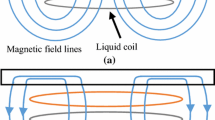Abstract
The purpose of this paper is to study the influences of wire length and alternating current (AC) amplitude on the tension-stress-impedance effect of FeCoNiBSiMo microwires. In this paper, the resistance, inductance, and impedance of FeCoNiBSiMo microwires under different conditions were measured; the resistance ratio, the inductance ratio, and the impedance ratio were calculated, then the resistance ratio, inductance ratio, and impedance ratio were linearly fitted to the wire length and the alternating current amplitude, respectively. The results showed that the tension-stress-impedance effect in soft magnetic microwires was enhanced with the decrease in the wire length. The impedance ratio reached a maximum of 11%, when an alternating current of 26 MHz was applied to the soft magnetic microwire with a wire length of 1.5 cm. The tension-stress-impedance effect in the same soft magnetic microwires was enhanced with the increase of the amplitude of the applied alternating current. The impedance ratio reached a maximum of 9%, when an alternating current with an amplitude of 25 mA and a frequency of 20 MHz was applied. Both linear fitting results showed high linearity, and the highest coefficient of determination was 0.9937.






Similar content being viewed by others
References
Luo, Z., Tang, Z., Jiang, L., Ma, G.: A referenceless image degradation perception method based on the underwater imaging model. Appl. Intell. 1–17 (2021)
Cardoso, S., Leitao, D.C., Dias, T.M., Valadeiro, J., Silva, M.D., Chicharo, A., Freitas, P.P.: Challenges and trends in magnetic sensor integration with microfluidics for biomedical applications. J. Phys. D: Appl. Phys. 50(21), 213001 (2017)
Tsukada, K., Hayashi, M., Nakamura, Y., Sakai, K., Kiwa, T.: Small eddy current testing sensor probe using a tunneling magnetoresistance sensor to detect cracks in steel structures. IEEE Transact. Magn. 54(11), 1–5 (2018)
Olivera, J., González, M., Varga, R., Zhukov, A., Anaya, J.J.: An embedded stress sensor for concrete SHM based on amorphous ferromagnetic microwires. Sensors. 14(11), 19963–19978 (2014)
Tomčíková, I., Bereš. M., Kováčová, I, et al.: Interaction between magnetic and stress field in ferromagnetic core of magnetoelastic pressure force sensor/2017 International Conference on Modern Electrical and Energy Systems (MEES). IEEE. 124–127 (2017)
Kurlyandskaya, G.V., Shcherbinin, S.V., Volchkov, S.O., Bhagat, S.M., Calle, E., Pérez, R., Vazquez, M.: Soft magnetic materials for sensor applications in the high frequency range. J. Magn. Magn. Mater. 459, 154–158 (2018)
Zhao, R.F., Ren, B., Zhang, G.P., Liu, Z.X., Cai, B., Zhang, J.J.: CoCrxCuFeMnNi high-entropy alloy powders with superior soft magnetic properties. J. Magn. Magn. Mater. 491, 165574 (2019)
Chen, C., Zhang, H., Fan, Y., Zhang, W., Wei, R., Wang, T., Li, F.: A novel ultrafine-grained high entropy alloy with excellent combination of mechanical and soft magnetic properties. J. Magn. Magn. Mater. 502, 166513 (2020)
Zuo, T., Zhang, M., Liaw, P.K., Zhang, Y.: Novel high entropy alloys of FexCo1-xNiMnGa with excellent soft magnetic properties. Intermetallics 100, 1–8 (2018)
Shen, L.P., Uchiyama, T., Mohri, K., et al.: Sensitive stress-impedance micro sensor using amorphous magnetostrictive wire. IEEE Trans. Magn. 33(3), 3355–3357 (1997)
Froemel, J., Akita, S., Tanaka, S.: Simple device to measure pressure using the stress impedance effect of amorphous soft magnetic thin film. Micromachines. 11(7), 649 (2020)
Zribi, A., Iorio, L.E., Lewis, D.J.: Oil-free stress impedance pressure sensor for harsh environment. In Sensors. 2005 IEEE (pp. 3-pp). IEEE (2005)
Beato-López, J.J., Vargas-Silva, G., Pérez-Landazábal, J.I., Gómez-Polo, C.: Giant stress-impedance (GSI) sensor for diameter evaluation in cylindrical elements. Sens. Actuators, A 269, 269–275 (2018)
Beato-López, J.J., Urdániz-Villanueva, J.G., Pérez-Landazábal, J.I., Gómez-Polo, C.: Giant stress impedance magnetoelastic sensors employing soft magnetic amorphous ribbons. Materials. 13(9), 2175 (2020)
Bukreev, D.A., Derevyanko, M.S., Moiseev, A.A., Semirov, A.V., Savin, P.A., Kurlyandskaya, G.V.: Magnetoimpedance and stress-impedance effects in amorphous CoFeSiB ribbons at elevated temperatures. Materials. 13(14), 3216 (2020)
Chen, Z., Li, D.R., Lu, Z.C., Zhou, S.X.: Giant stress-impedance effect in Co71. 8Fe4. 9Nb0. 8Si7. 5B15 glass-covered amorphous wires. J. Iron Steel Res. Int. 13(4), 49–50 (2006)
Chiriac, H., Óvári, T.A.: Amorphous glass-covered magnetic wires: preparation, properties, applications. Prog. Mater. Sci. 40(5), 333–407 (1996)
Wang, T., Wang, B., Liu, S., Luo, Y., Li, H., Liu, M., Xie, S.: Large negative tension-impedance effect in a soft ferromagnetic microwire. EPL (Europhysics Letters). 131(6), 60002 (2020)
Zhukova, V., Larin, V.S., Zhukov, A.: Stress induced magnetic anisotropy and giant magnetoimpedance in Fe-rich glass-coated magnetic microwires. J. Appl. Phys. 94(2), 1115–1118 (2003)
Goodno, B.J., Gere, J.M.: (2020). Mechanics of materials. Cengage learning.
Phan, M.H., Peng, H.X.: Giant magnetoimpedance materials: fundamentals and applications. Prog. Mater. Sci. 53(2), 323–420 (2008)
Landau, L.D., Lifshitz, E.M.: Electrodynamics of continuous media. Pergamon. (1984)
Knobel, M., Pirota, K.R.: Giant magnetoimpedance: concepts and recent progress. J. Magn. Magn. Mater. 242, 33–40 (2002)
Tannous, C., Gieraltowski, J.: Giant magneto-impedance and its applications. J. Mater. Sci. Mater. Electron. 15(3), 125–133 (2004)
Funding
This work is supported by the National Youth Natural Science Foundation (No.61703266), the National Natural Science Foundation of China (No.62073209), and the National Natural Science Foundation of China (No.52075315).
Author information
Authors and Affiliations
Corresponding author
Additional information
Publisher's Note
Springer Nature remains neutral with regard to jurisdictional claims in published maps and institutional affiliations.
Rights and permissions
About this article
Cite this article
Wang, T., Zhang, H. Influence of Wire Length and Alternating Current Amplitude on the Tension-Stress-Impedance Effect of FeCoNiBSiMo Microwires. J Supercond Nov Magn 35, 1375–1381 (2022). https://doi.org/10.1007/s10948-022-06299-1
Received:
Accepted:
Published:
Issue Date:
DOI: https://doi.org/10.1007/s10948-022-06299-1




